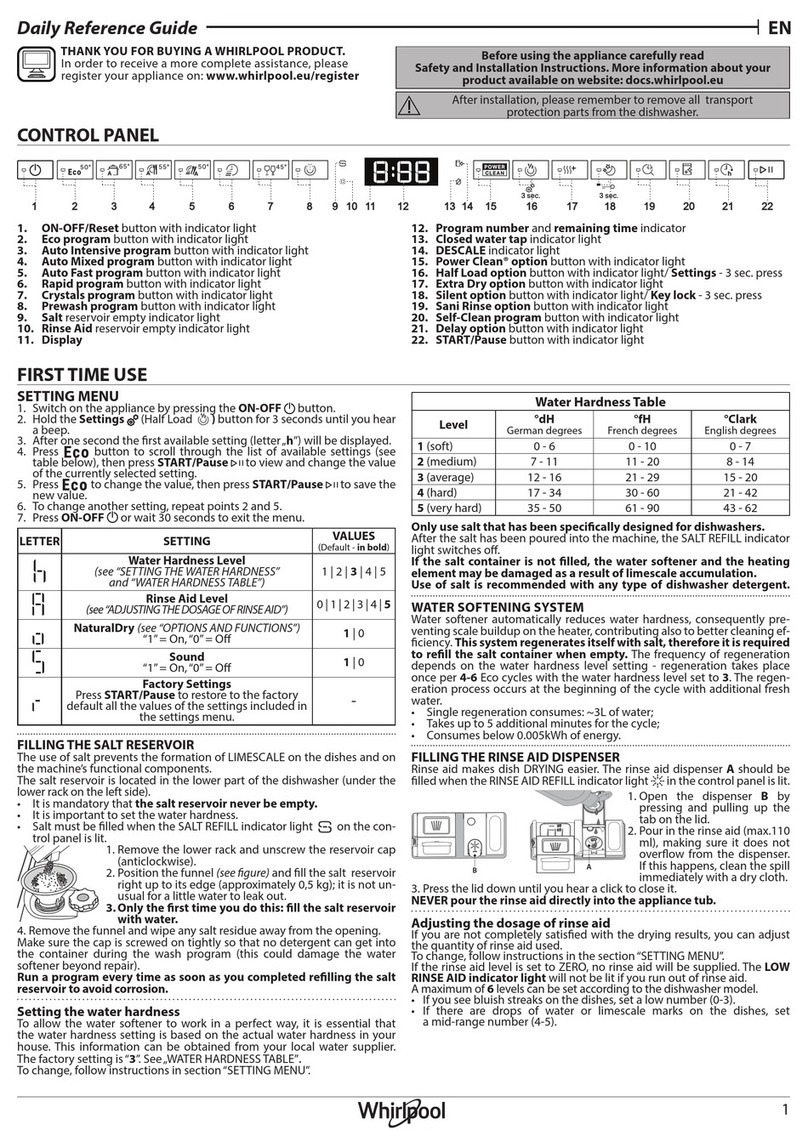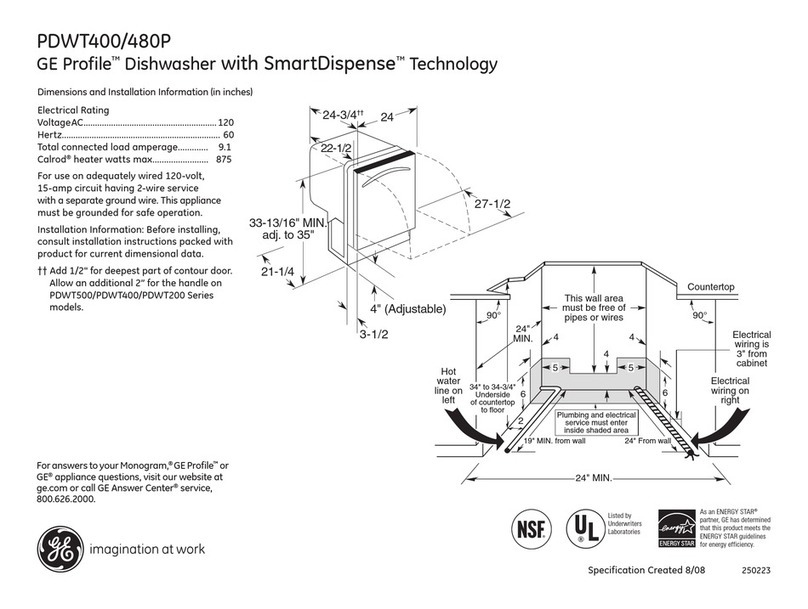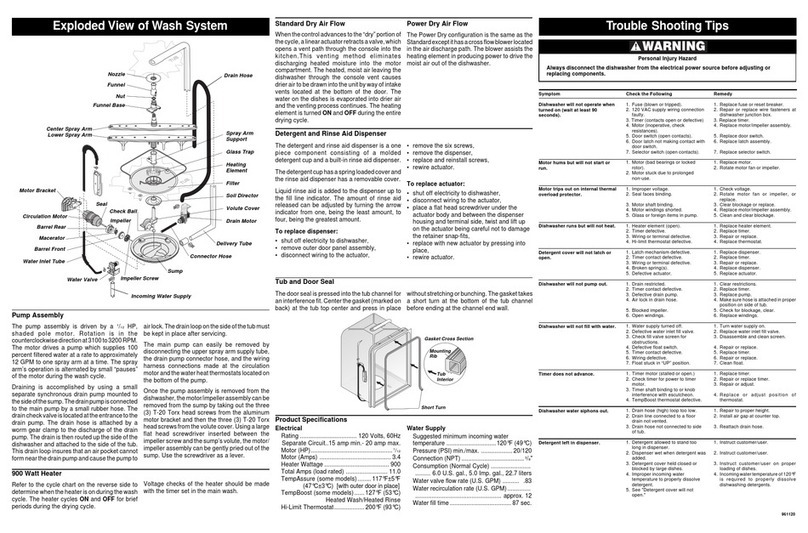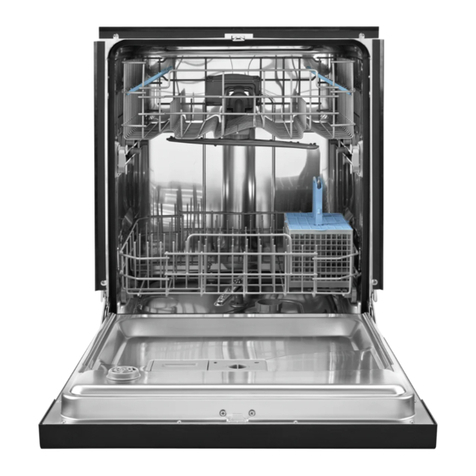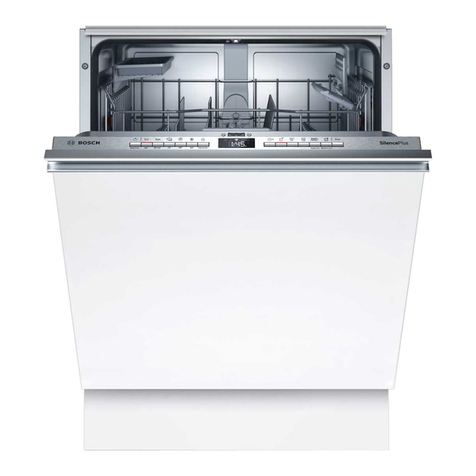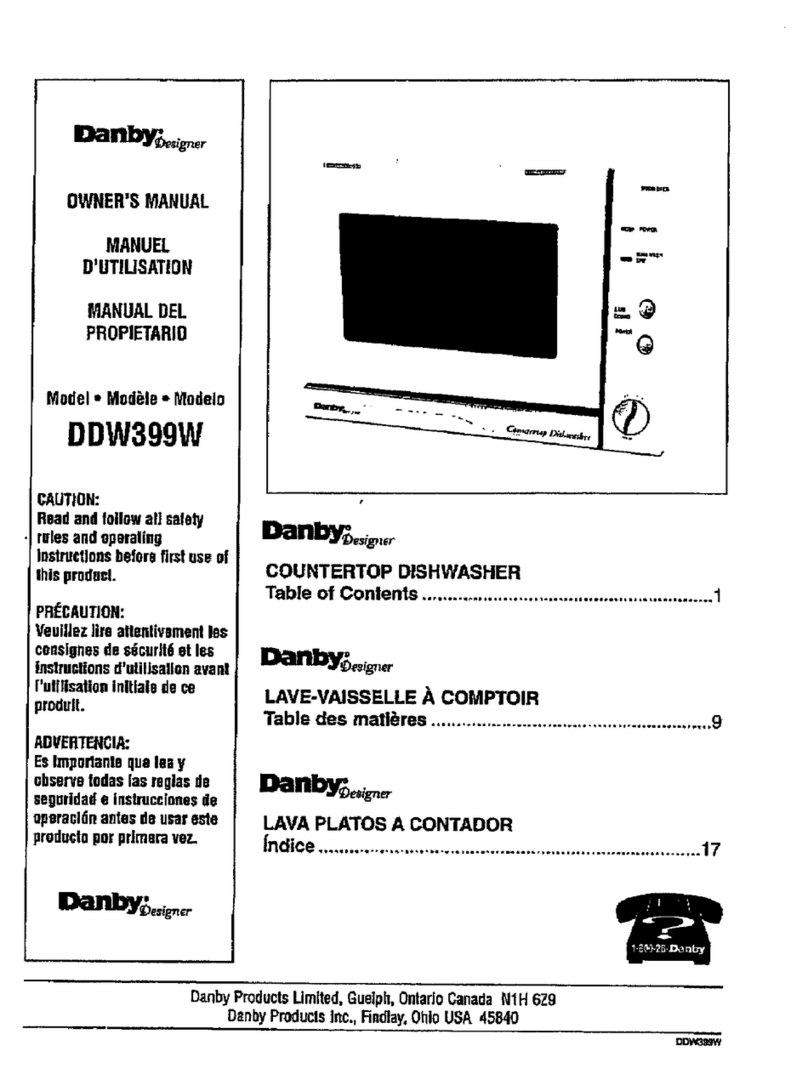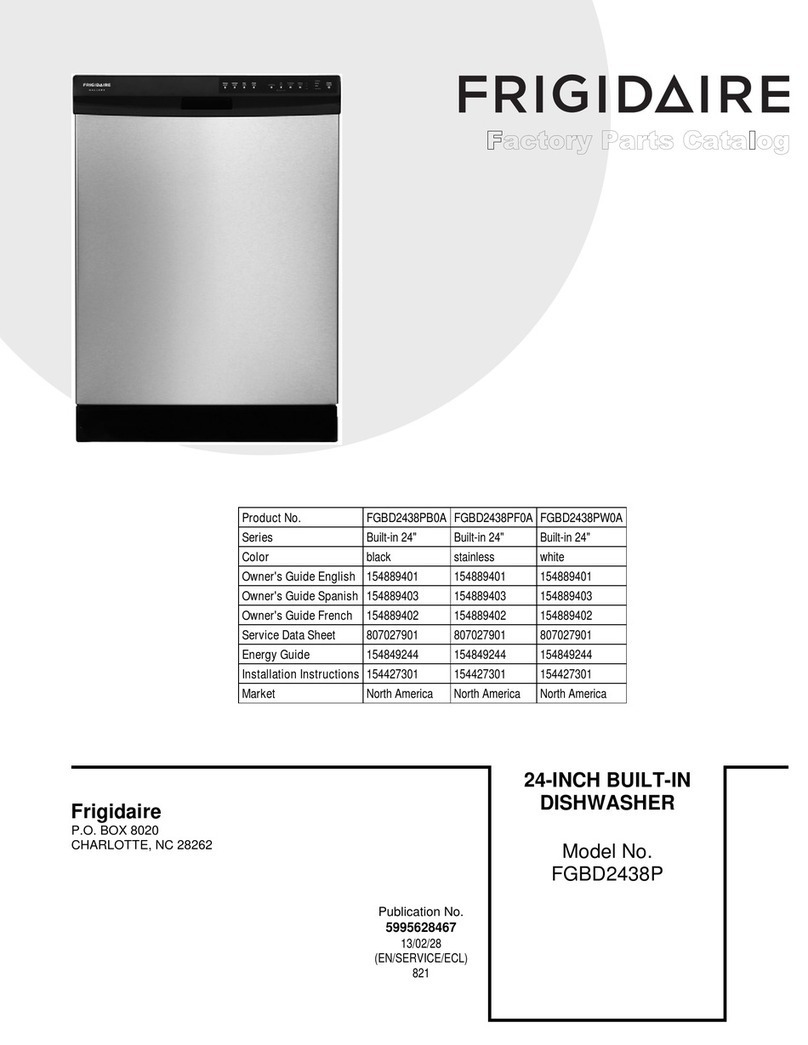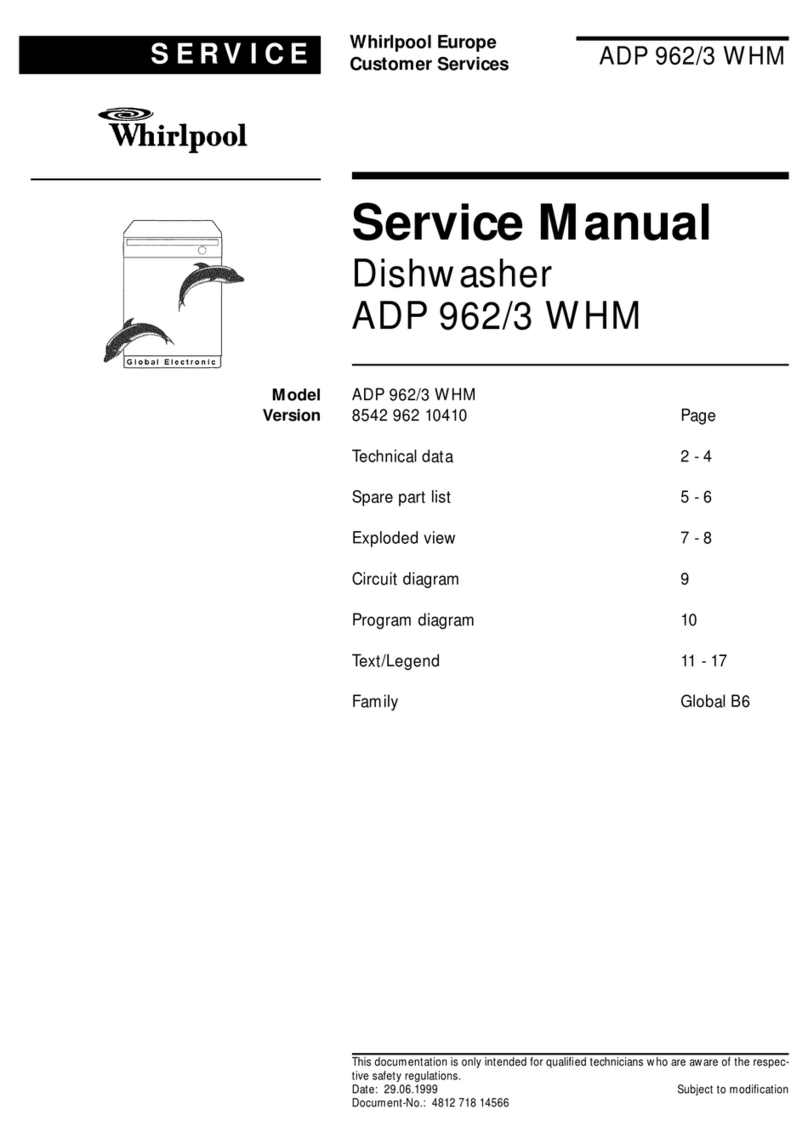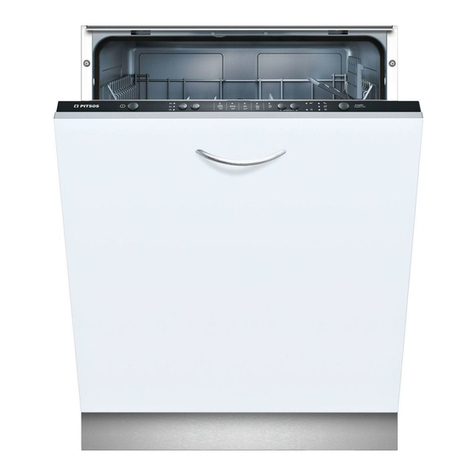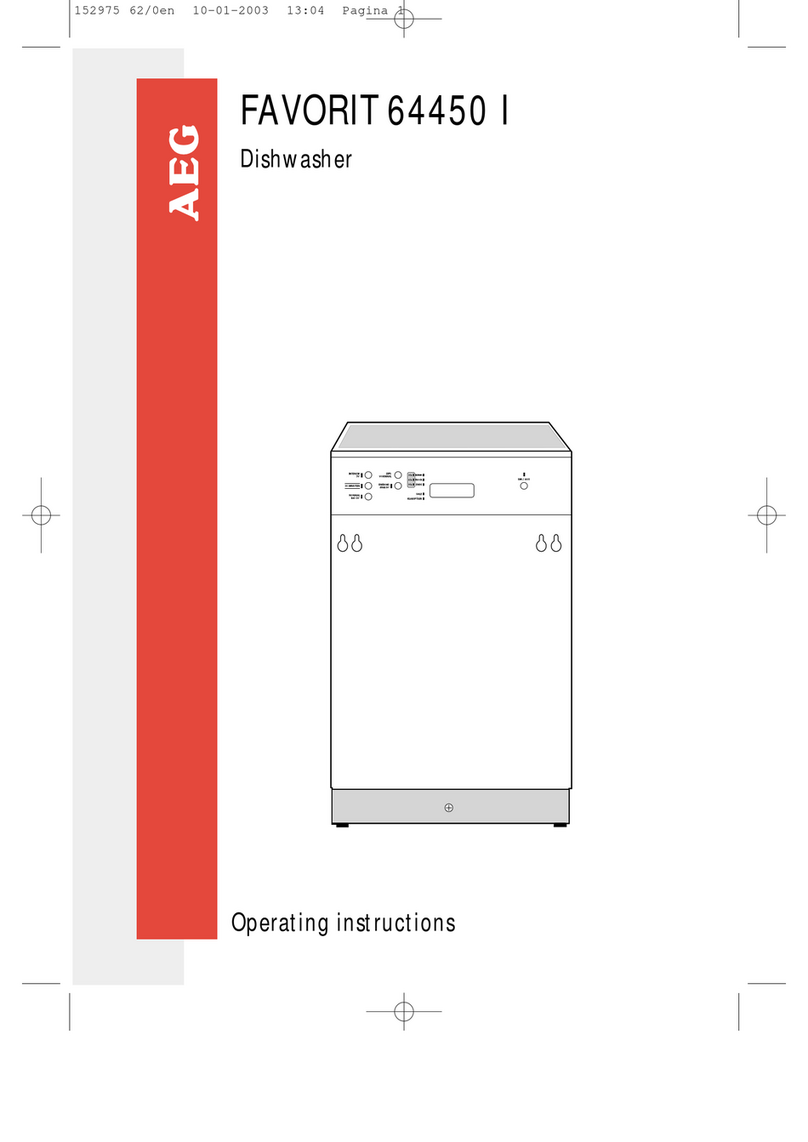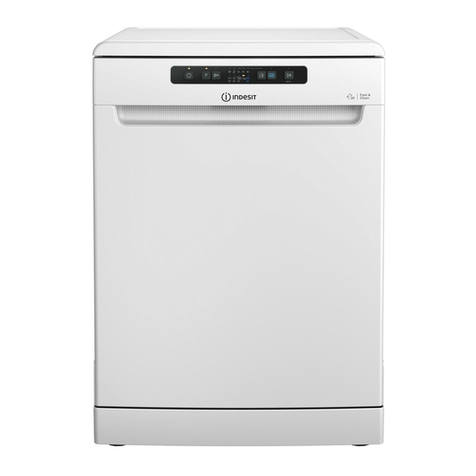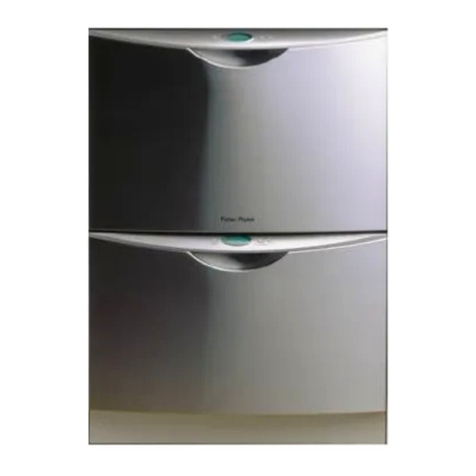Belling IDW450MK2 User manual

A
B
C
12
A
B
C
D
12
日期
签字
底图总号
旧底图总号
描校
描图
借(通)用件登记
日期
日期
标准化
处数
工艺
审核
设计
标记 更改文件号
审定
批准
校对
签名
张
第
张
共
广东美的集团股份有限公司
数量
阶段标记
量重
比例 D
美的洗涤电器制造有限公司
REV.
1
11
02
英文用户手册
英国
IDW450MK2(9337A)
BELLING
技术要求
印刷颜色为
规格为
如果供应商的排版需要加空白页 请加在最后
:
1. PANTONE BLACK C
2. A4
3. ,
105G双铜
6710003986

IDW450MK2

Witheachwashcycle.
Compartment
For programmes with pre-wash only.
(Follow the user instructions!)
Electric indicator on control panel (if provided).
Check the rinse aid level
(On models with water softener system only.)
Electric indicator on control panel (if provided).
If there is no salt warning light in the control panel
(for some models), you can estimate when to fill the salt into
the softener by the number of cycles the dishwasher has run.
Check the regeneration
salt level
Load the baskets
Select a programme
Close the door, turn on thewater tap. The machine will start working after about 10 seconds.
Running the dishwasher
Switch off the appliance
Turn off the water tap,
unload the baskets
Fill the detergent dispenser
Warning: wait a few minutes (about 15 minutes) before unloading the dishwasher to avoid handling
the dishes and utensils while they are still hot and more susceptible to break.
They will alsodry better.Unload the appliance, startingfrom the lower basket.
Changing theprogramme
Add forgotten dishes in the
dishwasher.
Scrape off any large amount of leftover food. Soften remnants of burnt food in pans,
then load the baskets. Refer to the dishwasher loading instructions.
Press the Programme button until the selected programme lights up.
( See the section entitled Operationg instruction )“”
When the working cycle has finished, the buzzer of the
dishwasher will sound 8 times, then stop.
Turn off the appliance using the ON/OFF button.
If the appliance is switched
off during a wash cycle.
Open the door carefully.
Hotsteam may escape
when thedoorisopened!
If the appliance is switched off during a wash cycle, when switched
on again, please re-select the washing cycle and operate the dishwasher
according to the original Power-on state ).
Switch on the appliance Press the On/Off button to switch on the appliance, Open the door.
1.Open the door a little to stop the dishwasher.
2.After the spray arms stop working, you can open the door completely.
3.Add the forgotten dishes.
4.Close the door, the dishwasher will start running again after 10 seconds.
C
For detailed operating method read the corresponding content onthe instruction manual.
1.A running cycle can only be modified ifit has been running for a short time. Otherwise the detergent
may have already been released and the water already drained. If this is the case, the detergent
dispenser must be refilled.
2. Open the door a little to stop the washing, then press the Program button for more than 3 seconds to
cancel the running programme.
3. Select a new programme, then close the door. The machine will restart after about 10 seconds.

DishwasherFeatures.................................... ...3
A Water Softener..................... ....................4、..
Attention before or after loading the Dishwasher
Baskets..........................................................9
Filtering System.............................................15
Caring for the Dishwasher..................... .........16.
How to use the 3 in 1function............................8
B Loading the Salt into the Softener.................5、
C Fill the RinseAid Dispenser.........................5、
D FunctionofDetergent.................................6
、
Loadingthe upper ...............................10Basket
LoadingtheLower ...............................10Basket
Cutlery Basket..............................................12
Therecommended method loading big
dishware.................................................... ...11
WashCycle Table...........................................13
Turning on theAppliance................................14
Changethe Programme.............. ................14....
At the End of the Wash Cycle...........................14
Before calling for service........................... .....24.
Errorcodes.................................... ..............25.
Technical information.............................. .....26..
ControlPanel...................................................3
.................................. 17Installation preparation ...18Aesthetic panel's dimensions and installation
..............20Tension adjustment ofthe door spring
.............................. 20Connection of drain hoses ......................... 21Dishwasher installation steps
About Electricity Connecting...........................22
Cold Water Connection.................................. 23
Hot ............. 23Water Connection.....................
To review the section on troubleshootingTips
willhelp youto solve some common problems
by yourself .
Dear Customer,
Please carefully read thismanual beforeusing the
dishwasher, it will help you to use and maintain the
dishwasher properly.
Pass it onto any subsequentowner of the appliance.
This manual contains sections on safety Instructions,
OperatingInstructions,InstallationInstructionsand
Troubleshooting Tips, etc.
The manufacturer, following a policy of constant
developmentand updating of the product, may
make modificationswithout giving prior notice.
Keep it to refer to it at a laterdate.
If you can not solvethe problems by yourself ,
please ask forthe help of professional technicians.
Thisappliance is intended tobe used in household
and similar applications such as:
-staff kitchen areas in shops, offices and other
working environments;
-farmhouses;
-by clients inhotels, motels and other residential
typeenvironments;
-bed and breakfast type environments.

This appliance must be grounded. In the event of a
malfunction or breakdown, grounding will reduce
the risk of anelectric shock by providing a path of
least resistance of electric current. This appliance
is equipped with a cord having an equipment-
grounding conductor and a grounding plug.
The plug must be plugged into an appropriate outlet
that is installed and grounded in accordance with
all local codes and ordinances.
Improper connection of the equipment-grounding
conductor can result in the risk of an electric shock.
Check with a qualified electrician or service
representative if you are in doubt whether the
appliance is properly grounded. Do not modify the
plug provided with the appliance; If it does not fit
the outlet. Have a proper outlet installed by a
qualified electrician.
Keep children away from detergent and rinse aid, keep
child away from the open door of the dishwasher,
there could still be some detergent left inside.
ren
Do not abuse, sit on, or stand on the door or dish
rack of the dishwasher.
Do not touch the heating element during or
immediately after use.
(This instruction is only applicable to machines
with a visual heating element.)
Do not wash plastic items unless they are marked
dishwasher safe or the equivalent. For plastic items
not so marked, check the manufacturer's
recommendations.
Useonly detergent and rinse additives
designed for an automatic dishwasher.
Never use soap, laundrydetergent, or hand
washing detergent in your dishwasher. Keep
these products out of the reach of children.
During installation,thepowersupplymustnot
beexcessively ordangerouslybent orflattened.
Do not tamper with controls.
Do not place any heavy objects the
door when it is open. The appliance could tip
forward.
on or stand on
When loading items to be washed:
1)Locatesharp itemssothat theyarenot likely
todamagethedoorseal;
2 Warning: Knives and otherutensils with
sharp points must be loaded in the basket
with their pointsdown or placedin a
horizontalposition.
)
When using your dishwasher, youshould
prevent plastic items from comingintocontact
withthe heating element.(This instruction is only
applicable to machines with a visual heating
element.)
Ifthe supply cord is damaged, it must be replaced
by themanufacturer or itsserviceagent ora
similarly qualified person in order to avoid a
hazard.
Please dispose of packing materials properly.
Use the dishwasher only for its intended function.
Remove the door to the washing compartment when
removing an old dishwasher from service or discarding it.
Dishwasher detergents are stronglyalkaline, they
can be extremely dangerous if swallowed.Avoid
contact with skin and eyesandkeep children away
from the dishwasher when the door is open.
Check that the detergent comparment isempty
after completionof the wash cycle.
The applianceis to be connected to the water
mains using new hosesets and that oldhose-sets
should not be reused.
The maximumnumber of place settings tobe
washed is 8.
The maximumpermissibleinlet water pressureis
1MPa.
The minimumpermissibleinlet water pressureis
0.04MPa.
Children should besupervised to ensure that they do
not play with the appliance.
This appliance is not intended for use by persons
(including children with reduced physical, sensory or
mental capabilities, or lack of experience and
knowledge ,unless they have been given supervision
or instruction concerning use of the applianceby a
person responsible for their safety.
)
When using your dishwasher, follow the precautions listed below:
The door should not be left open,
since this could increase the risk of tripping.
Do not operate your dishwasher unless all
enclosure panels are properly in place. Open
the door very carefully if the dishwasher is
operating, there is a risk of water squirting out.

Dispose of the dishwasher packagingmaterial correctly.
All packaging materialscanbe recycled.
Plastic parts aremarked with thestandard international abbreviations:
PE for polyethylene,e.g. sheet wrapping material
PS for polystyrene, e.g.paddingmaterial
POM polyoxymethylene, e.g. plastic clips
PP polypropylene, e.g. Salt filler
ABS Acrylonitrile Butadiene Styrene, e.g.Control Panel .
Packaging material couldbedangerousfor children!
Fordisposing ofpackage and theappliance please goto a recycling centre. Therefore cut
off the powersupplycable and make the doorclosingdevice unusable.
Cardboard packaging ismanufactured fromrecycled paperand shouldbe disposedin the
waste paper collection for recycling.
By ensuring this productis disposed of correctly, you will help prevent potential negative
consequences for the environment and human health, which could otherwise be caused
by inappropriatewaste handling of this product.
Formore detailed information about recyclingof this product, please contact your local
cityoffice and your household waste disposal service.
DISPOSAL: Do not dispose this product as unsorted municipal waste. Collection of such
waste separately for special treatment is necessary.

11 12
Back View
1
2
3
4
5
6
7
8
9
10
on
Of f
Front view
5
Program button:To select one of the six programs. .
2
3
4
3in1 button:To selectandshow 3in1functions.
Display window: Program remaining time, delay time,
running indicator, Program indicator, Salt and rinse
aid indicator, Error codes, etc.
Power switch:To turn on/off the power supply.
DelayedStartButton:Topresetthewashtimeranddelay
the starting time up to 24 hours. Every press of this button
increases the timeby one hour.
for example: one press for an hour, two for two
hours... ...
(
)
MainFilter
Detergent Dispenser
CupShelf
CutleryBasket
CoarseFilter
RinseAidDispenser
Inlet pipe connector
Drain pipe connector
Lower Basket
SprayArms
UpperBasket
1
Salt Container
beforeusingit for the first time.
To getthe best performance fromyourdishwasher, read all operatinginstructions
5
6
7
8
9
10
12
11
3
24
2345
IDW450

Before using yourdishwasherfor the first time:
The water softener must be set manually, usingthewater hardness dial.
The water softeneris designed to remove minerals and salts from thewater,which wouldhave
a detrimentalor adverse effect on the operation of the appliance. The higher the
content of these minerals and salts, the harder your water is. The softener should be
adjusted accordingto the hardness of the water in yourarea.Your localWaterAuthority
can advise you onthehardnessofthewaterinyourarea.
Adjusting Salt Consumption
The dishwasher isdesigned toallow for adjustment in the amount ofsalt consumed based onthe hardness of
the waterused.This isintended tooptimiseand customisethelevelo f salt consumption.
1. Unscrewthe cap fromthe saltcontainer.
2. There is aring on the container with an arrow on it (see figure
ontheside), ifnecessary, rotate thering inthe anticlockwise
direction from the "-" Setting toward the"+"sign, based on the
hardness ofthe waterbeing used.
It is recommendedthat adjustments should be made in
accordance withthe following scheme:
WATER SOFTENER
Thehardness ofthe watervariesfrom place to place. If hard water isused inthe dishwasher, deposits will
form on the dishesand utensils.
The applianceisequipped with a special softener that uses a salt container specifically designed to eliminate
lime and minerals from the water.
Contact your local water board for information on the hardness of your water supply.
dH mmol/l
0~140~8 0~1.4 /0/
14~398~22 1.4~3.9 - 20 50
39~8022~45 3.9~8 Mid 40 25
+60 16
fH
0~10
10~28
28~56
Clarke
°Clark: British degree
°fH: French degree
°DH: German degree
WATER HARDNESS
SelectorPosition Salt consumption
(gram/cycle) Auto nomy
(cycles/1kgs)
Please follow the steps below for adjustment in salt consumption.
""/
"-"
"+"
"Mid"
Settingtowardthe"+"sign
Settingtowardthe"-"sign
Settingtowardbetween
the "-" sign and "+" sign
No salt need added
45~60 80~107 56~75 8~11
If your model does not have any water softener, you mayskip this section.
A. Set the watersoftener
B. Pour 1 2 litre ofwater insidethesaltcontainer andthen fill withdishwashersalt/
C. Filltherinseaiddispenser
D. Fill in detergent
dH=1.25Clarke=1.78fH=0.178mmol/l
°°°
1

normal fora small amount of water to come out of the salt container.Itis
1. The salt container must only be refilled when the salt warning light in the control panel comes on.
Depending on how well thesalt dissolves, thesalt warninglight may still be on even though the
salt container is filled.
If there is no salt warning light in the control panel (forsome Models),you can estimate whento fill
the salt into the softenerby the cycles that the dishwasher has run.
2. If there are spills ofthe salt,a soakor a rapid program should be run to remove the excessive salt.
Always use the salt intendedfor use with dishwasher.
The salt containeris located beneath the lower basket and shouldbe filled as explained
inthe following:
Attention!
Only use salt specifically designedforthe use indishwashers! Every other type of
salt not specificallydesigned for theuse in a dishwasher, especially table salt, will
damage thewater softener. In caseof damages caused by the use of unsuitable
salt the manufacturerdoes notgive anywarranty nor is liable for any damages caused.
Only fill withsalt just before startingone of thecomplete washingprograms.
This will prevent any grains of salt or salty water, which may have been spilled,
remaining on the bottom of the machinefor anyperiod of time, which may cause
corrosion.
The rinse aid isreleasedduring the final rinseto prevent water from forming droplets onyour dishes, which can
leave spots andstreaks. Italso improvesdryingby allowing water toroll offthe dishes. Your dishwasheris
designed touse liquid rinseaids.The rinseaiddispenser islocated inside thedoornext to the detergentdispenser.
To fill the dispenser, open the cap and pour the rinse aid into the dispenser until the level indicator turns completely
black. The volume ofthe rinse aidcontaineris about 110ml.
RinseAid Dispenser
Function of RinseAid
Rinse aid is automatically added during the last rinse, ensuring thorough rinsing, and spotand streak free drying.
Attention!
Only usebranded rinse aid for dishwasher. Neverfill the rinse aid dispenserwithanyothersubstances
(e.g. Dishwasher cleaning agent, liquid detergent). This would damage the appliance.
ARemove the lower basket and then unscrew andremovethe capfromthesaltcontainer.
BBefore thefirst wash,fill 1lt. of water in the salt container of your machine.
CPlace theend of the funnel (supplied) into the hole and introduce about 1kg of salt.
DAfter filling the container, screw the cap tightly back clockwise.
EUsually, the salt warning light will stop being illuminated within 2-6 days afterthesalt containerhasbeen filled with
salt.
FImmediately after filling the salt into the salt container, a washing program should be started
program Otherwise the filter system, pump or other important parts of the machine may be damaged
bysalty water.This isoutofwarranty.
(Wesuggest to use the
soak orrapid ).

To open the dispenser, turn the cap to the "open" (left) arrow and lift it out.
Pourthe rinse aid into the dispenser, being careful not tooverfill.
Replace the cap by inserting italigned with "open" arrow and turning it to the closed (right) arrow.
Adjusting RinseAid Dispenser
The rinse aid dispenser has six or four settings. Always start with the dispenser
set on"4". If spots and poor dryingare a problem, increase the amount of rinse
aid dispensedby removing thedispenser lid and rotating the dial to "5".If the
dishes still are not drying properly or are show spots,adjustthe dial to the next
higher lever until your dishes are spot-free. The recommended setting is "4".
(Factory value is "4".)
Increasethe dose if thereare drops of waterorlimespotson the dishes after washing.
Reduce it ifthere aresticky whitish stains on your dishes or abluish film on glassware or
knife blades.
1
2
3
As the rinse aid diminishes, the size of the black dot
onthe rinse aidlevel indicator changes,as illustratedbelow.
Full
3/4full
1/2full
1/ 4full-Should refilltoeliminate spotting
Empty
When to Refill the Rinse Aid Dispenser
Ifthereis no rinse-aid warning lightin thecontrolpanel, you can estimate the amount from the colour
of the optical level indicator C located next to thecap. When the rinse-aidcontainer isfull, the whole
indicator will be dark .As the rinse-aid diminishes, thesize of the dark dot decreases. You should never let
the rinse aid level fall 1 / 4 full.
duringthe next wash.
Don'tforget to replacethe cap before you closedishwasher door.
Clean up any rinse aid spilled while during filling with an absorbent cloth to avoid excessive foaming
Detergents with its chemical ingredients arenecessary toremove dirt,crushdirt and transport it outof the dishwasher.
Mostofthe commercial qualitydetergentsare suitable forthispurpose.
Detergents
Thereare 3 sorts of detergents
1.Withphosphate andwithchlorine
2.With phosphate and without chlorine
3.Withoutphosphate and without chlorine
""

Amount ofDetergentto Use
Proper Use of Detergent
Use only detergentspecificallymade for the usein dishwashers. Keep your detergent fresh and dry.
Don't putpowdereddetergentinto the dispenseruntilyou'reready towash dishes.
Dishwasher detergent iscorrosive! Takecare to keepit out of reach of children.
Based ontheir chemicalcomposition, detergentscan besplitin twobasic types:
Detergenttablets of different brandsdissolve at differentspeeds. For this reasonsome
detergenttablets cannot dissolve and develop theirfull cleaning power during short
programs. Therefore please use long programs when usingdetergent tablets, to
ensure the complete removal of detergent residuals.
The dispensermust berefilledbefore the start of each washcycle following the instructions
provided in the wash cycle table . Your dishwasher uses less detergent and rinseaid than
Conventional dishwasher.Generally, only one tablespoon of detergent is neededfor
anormal washload. Moreheavily soileditems need moredetergent.Alwaysaddthe
detergentjustbefore starting the dishwasher, otherwiseit couldgetdamp and will not
dissolve properly.
Concentrated Detergent
DetergentTablets
DetergentDispenser
Always add the detergent just before starting eachwash cycle.
Only use branded detergent aidfordishwasher.
If the lid isclosed: press release button.The lid will spring open.
conventional, alkaline detergentswith causticcomponents
low alkaline concentrated detergents with natural enzymes
Normally new pulverised detergent is without phosphate.Thus the watersoftenerfunction of
phosphate is not given. In this case we recommend to fill salt in the salt container even when
the hardness of water is only 6 dH. If detergents without phosphate are used in the case of hard water
often white spots appear on dishes and glasses. In this case please add more detergent to reach
better results. Detergents without chlorine do only bleach a little. Strong and coloured spots will not
be removed completely. Inthiscase please choose a program with a higher temperature.
°

Fill the detergent dispenser with detergent.
The marking indicates the dosing levels , as
illustrated on the right:
Theplace of main wash cycle detergent placed,
MIN means approximately20gof detergent.“”
Theplace of pre-wash cycle detergent placed ,
approximately 5gof detergent
Please observe themanufacturers dosing and storage
Recommendationsas stated onthedetergent packaging.
Closethe lid and press untilit locks in place.
If the dishes are heavily soiled, place an additional
detergent dosein the pre-wash detergent chamber. Thisdetergent will take effectduring the pre-wash phase.
A
B
Fill in Detergent
You findinformation about the amount ofdetergent for thesingle programme onthe last page.
Pleaseaware, that according tothe level soiling and the specific hardnessof waterdifferencesarepossible.
Pleaseobserve themanufacturer's recommendationson the detergent packaging.

Cutlery with wooden,horn china or
mother-of-pearl handles
Plasticitems that arenot heat resistant
Older cutlerywith glued parts that arenot
temperatureresistant
Bonded cutlery itemsor dishes
Pewter or cooper items
Crystal glass
Steel items subject to rusting
Wooden platters
Items madefromsyntheticfibres
Some types of glasses canbecome
dull aftera large number of washes
Silver and aluminum parts have a
tendencyto discolourduringwashing
Glazed patterns may fade ifmachine
washed frequently
Are not suitable Are oflimited suitability
Dishesand itemsof cutlery mustnot lie insideoneanother, or cover each other.
To avoiddamage to glasses,theymust not touch.
Load large items which are mostdifficult to cleanintothe lowerbasket.
The upper basket is designed to holdmore delicate and lighter dishware such as glasses, coffee
andteacups
Long bladed knives stored in an uprightpositionare a potential hazard!
Long and/orsharp itemsof cutlery such as carving knivesmust be positioned
horizontallyin the upperbasket.
Please do not overload yourdishwasher. This is important forgood resultsandfor
reasonable consumption of energy.
Load hollow items suchas cups, glasses, pans etc. With the opening facing downwards so that
water cannot collect in the container or a deepbase.
Usea mild detergentthatisdescribedas 'kind todishes'. If necessary, seek further
information from thedetergent manufacturers.
Forparticular items, select aprogramwith aslow atemperature aspossible.
Consider buyingutensilswhich are identifiedas dishwasher-proof.
To prevent damage, do not take glassand cutlery out of the dishwasher immediately
after the programmehas ended.
(For best performance of the dishwasher, follow these loading guidelines.
Features and appearance ofbaskets and cutlery basketsmay vary from your model.)
Scrape off any largeamounts of leftover food. Soften remnants ofburnt food inpans.
It is not necessary to rinse the dishes under running water.
Place objects inthe dishwasher in following way:
1.Items such ascups, glasses, pots/pans, etc. are faced downwards.
2.Curved items, or ones with recesses, should be loaded aslant so that water can run off.
3.All utensils are stacked securely and can not tip over.
4.All utensils are placed in the way that the spray armscan rotate freely during washing.
Very small items should not be washed in the dishwasher as they could easily fall out of the basket.
To prevent water drippingfrom the upper basket into the lower basket, we recommend that you
empty the lower basket first and then the upper basket.

Theupperbasket isdesigned to holdmore delicate andlighter dishwaresuchas glasses,coffee
and tea cups and saucers, as well as plates, small bowls and shallowpans (as long as they are
not toodirty).
Position the dishes and cookware so that they will not get moved by the spray of water.
Wesuggest that you place largeitems and the most difficult to clean items are tobe placed into thelower basket:
such as pots, pans,lids, serving dishesandbowls, as shown in the figure below.
It is preferableto place serving dishes and lids on theside of theracks inorder toavoid blocking the rotation ofthe
topspray arm.
Pots, serving bowls, etc, must always be placed top down.
Deep pots should be slanted to allow water to flow out.
Please be reminded that:
TheBottomBasket features folding spikesso that larger or more pots and panscan be loaded.
1
Cups
2
Small serving bowl
3
Large serving bowl
4
Glasses
Saucers
5
6
Dish
12
3
4
6
5
1
Oval platter
3
Soup plates
Dessertdishes
4
2
Dinner plates
5
Silverware basket
2
3
4
1
5
4


Cutlery should be placed in the cutlery basket with the handles at the bottom. If the rack has side baskets,the
spoons should be loaded separately into the appropriate slots,especially long utensils should beplaced in the
horizontal position at the front ofthe upperbasket as shown in the picture.
Folding Spikes of Lower Basket
For better stacking of pots and pans,
the spikes can be folded down as
show in the picture right.
Adjusting the Upper Basket
The height of the upper basketcan be adjusted in orderto create more space for large utensils
both for the upper/lower basket. The height of theupper basket can be adjusted by placing the
wheels on different height of the rails. Long items, serving cutlery, salad servers andknives
should be placed on the shelfso that they do not obstruct the rotationof the sprayarms.
The shelf can be folded back or be removed when not required for use.
Upper wheels
Lower wheels
For personalsafety and a topquality cleaning,place the silverware in the basket
making sure that:
They do not nest together.
Silverware is placed with the handles-down.
Butplace knives and other potentially dangerousutensils areplacedhandles-up.
Do not let any item extend through bottom.
Teaspoons
4
Soup spoons
2
Forks
1
Serving fork
8
Serving spoon
6
Knife
5
3
Dessertspoons
7
Gravyladle
1
1
1
1
1
4
7
8
1
1
1
6
2
2
2
2
2
2
2
2
5
5
5
5
5
5
5
5
3
3
3
6
4
4
4
4
4
4
4
3
3
3
3
3

Eco.
Intensive
Normal
(*EN 50242)
(or )3in1
4/23g
(or )3in1
4/23g
(or )3in1
4/23g
Rapid
Rinse
Glass
Pre-wash(50 )
Pre-wash
Wash (65 )
Rinse
Rinse
Rinse (55 )
Drying
℃
℃
℃
Pre-wash
Wash (40 )
Rinse
Rinse (60 )
Drying
℃
℃
Pre-wash(50 )
Wash (50 )
Rinse
Rinse(65 )
Drying
℃
℃
℃
Pre-wash
Wash (55 )
Rinse (65 )
Drying
℃
℃
Wash (40 )
Rinse ℃
Rinse (45 )℃
15 g.
15 g.
Wash(40 )℃
Rinse (70 )
Drying ℃
150
160
120
30
80
0.95
1.2
0.4
0.65
95 0.65
18
13
7
10
12
Means:need to fill rinse into the Rinse-Aid Dispenser.
()
*EN 50242 : This programme is the test cycle. The information for comparability test
in accordance with EN 50242, as follows:
Capacity:8 setting
PositionUpper basket: upper wheels onrails
Rinse aid setting: 6
0.81 12.5
For heaviest soiled crockery,
and normally soiled pots
pans dishes etc with dried
on soiling.
、
、
For normally soiled loads,
such as pots plates
glasses and lightly
soiled pans.
、、
Standard daily cycle for
normally soiled loads,
such as pots plates
glasses. 、、
For dishes that need to be
rinsed and dried only.
For lightly soiled crockery
and glass.
A shorter wash for lightly
soiled loads and quick wash.
The power consumption of off-mode is 0 W
left-onmodeis1.4W

It is dangerous to open the door when washing, because the hot water may scald you.
When the working cycle has finished, the buzzer of the dishwasher will soundfor8 seconds, then stop. Turn off
the appliance using the ON/OFF button, shut off the water supply and open the door of the dishwasher.
Wait for afew minutes before unloading thedishwashertoavoidhandlingthedishes and utensils while they
are still hot and more susceptible to breakage. Theywill also drybetter.
Switch Off the Dishwasher
The program has ended, only if there appears a "-:--" in the digital display (remaining program time).
1.Switch off the dishwasher by pressing the ON/OFF button.
2.Turnoffthewatertap!
Open thedoor carefully.
Hot dishes are sensitive to knocks. The dishes should thereforebeallowed to cool down around 15 minutes
before removingfrom the appliance.
Open thedishwasher's door, leave it ajar and wait a few minutes before removing the dishes. In this way they
will be cooler andthe drying will be improved.
Unloadingthedishwasher
It is normal that the dishwasher is wet inside.
Empty thelower basket first and thenthe upperone.Thiswill avoid water dripping from the upper Basket onto
the dishes in the lower one.
the machine will working after 10 seconds.continue
Ifyou openthe door , the machine will pause. When you close the door ,during a wash cycle
1 Draw out the lower and upper basket, load the dishes and push them back.
It iscommendedtoloadthelowerbasketfirst,thentheupperone(seethe sectionentitled
Loading the Dishwasher ).
2 Pour in the detergent (see the section entitled Salt, Detergent and RinseAid ).
3 Insert the plug into the socket. The power supplyis 220-240 VAC /50 HZ, the specification of the
socket is 10A 250VAC. Make sure that the watersupply is turnedon to full pressure.
4 Press the ON/OFF button, and the ON/OFF lightorthe display will turn on. Press theprogram
button to select a desired wash cycle. fter 10 seconds, the machine will work.
“”
“”
Closethe door,a
1 Acycle thatis underway can only be modified if ithas only been running for a short
time. Otherwise, thedetergent mayhave already been released, and theappliance may
have already drained the wash water. If this is the case, the detergent dispenser must
be refilled (seethe section entitled " Loading the Detergent " ).
2 Openthe door alittletostopthe washing.Pressthe programme buttonmore than 3 seconds to cancel therunning
programme. Then you can select otherprogrammes (see the section entitled" Starting a wash cycle.. . " ).
3 When you select Intensive/Normal/Eco.Programmes,you can select the3in1 function.
Aforgotten dish can be added any time before the detergent cup opens.
Add forgotten dishes.
Close the door
After the spray arms stop working,you can open the door
completely.
2
3
Open the door a little to stop the washing.
14
5
The dishwasher will run after 10 seconds.
Premise

The filter preventslarger remnantsof food or other objects from getting insidethepum.
Theresidues may blockthefilter, inthiscasethey mustbe removed.
The filter system consists of a coarse filter,a flat (Mainfilter)
And a microfilter(Fine filter).
Food and soil particles trapped inthisfilter arepulverizedby a
special jet on the lower spray arm and washed down todrain.
Larger items, such as pieces of bones or glass, that could block
thedrainaretrappedin the coarse filter.To remove theitems
caught by the filter, gently squeeze the tap on thetop of this
filterandliftout.
Thisfilter holds soiland foodresiduesin the sumpareaand
preventsit from being redepositon the dishes duringwashcycle.
Main filter
1
Coarse filter
2
Fine filter
3
2
3
1
Filter assembly
Thefilter efficiently
For best performance and results, the filter must be cleaned regularly. thisreason, it is a goodidea to
remove thelarger food particles trappedin the filter aftereach washcycle by rinsing the semicircular filterand
cup under running water. To remove thefilter device,pull thecup handle in the upward direction.
removes food particles from thewash water,allowing it to be recycled during the cycle.
For
The dishwasher must never be used without the filters.
Improper replacement of the filter may reduce the performancelevel ofthe appliance
and damage dishesand utensils.
Step 1 Turn the filter in anti-clockwise direction,
then lift it up.
:
Step 2 lift the Main filterup:
Step 3 lifttheFinefilter up:
When following this procedure from step1 to step 3, the filter system will be removed;
when following it from Step 3 to Step 1, the filter system will be installed.
1
2
3

The control panel can be cleaned by using a lightly dampenedcloth.
Aftercleaning, make sure to dry it thoroughly.
For the exterior, use agood appliance polish wax.
Never usesharp objects, scouring pads orharsh cleaners on any part of the dishwasher.
ProtectAgainst Freezing
1.Cutoffthe electrical power to thedishwasher.
2.Turn off the water supply and disconnect the water inlet pipe from the water valve.
3.Drain thewater from the inlet pipe and watervalve. (Use a pan to catch the water)
4.Reconnect the water inlet pipe to the water valve.
5.Remove the filter at the bottomof the tub and use a sponge to soak up water in the sump.
please take frost protection measures onthe dishwasher in winter.Every fter washingcycles,
please operate as follows time a
:
- Inspect the filters for blocking after everytime the dishwasher has beenused.
- By unscrewing the coarse filter, you can remove the filter system.Removeanyfoodremnants and
cleanthefilters underrunningwater.
Remarks:
Cleaning the Filter
CleaningThe Door
To clean the coarsefilter and the fine filter, use acleaning brush. Reassemble thefilter parts as shown in the figures
on thelast page and reinsert the entire assembly in the dishwasher, positioning it in itsseat and pressing downwards.
The entirefilter assembly shouldbe cleanedonce a week.
Whencleaning the filters, don't knock on them. Otherwise, thefilters could be
contorted andtheperformance ofthe dishwashercouldbedecreased.
To clean theedge around the door, you shoulduseonly a soft warm, damp cloth.
To avoid penetrationof water into the door lock and electrical components,do not
use a spray cleaner of any kind.
Never use a spray cleaner toclean the door panel as it may damage the door lock
and electricalcomponents.
Abrasive agents or some paper towels should not be used because of therisk of
scratching or leaving spots on the stainless steel surface.
Cleaning the SprayArms
If your dishwasher cannot work because of the ice,
please contact professional service persons.
It is necessary to clean thespray armsregularly forhard water
chemicalswillclogthesprayarmjetsand bearings.
To remove theupper sprayarm,screwoff the nut clockwise then
remove the arm.
To remove thelower spray arm, pull out .thesprayarmupward
Wash thearms in soapy and warm water and use a softbrushtoclean
the jets. Replace them after rinsing them thoroughly.
Table of contents
Other Belling Dishwasher manuals

Belling
Belling bdw60ss User manual
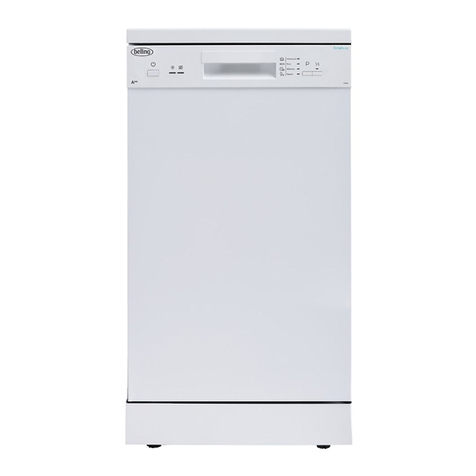
Belling
Belling BEL FDW90 WHI User manual
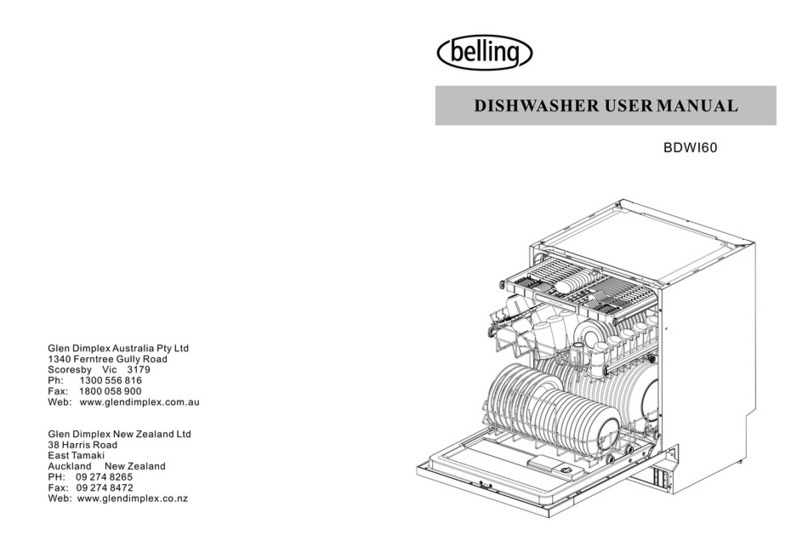
Belling
Belling BDWI60 User manual
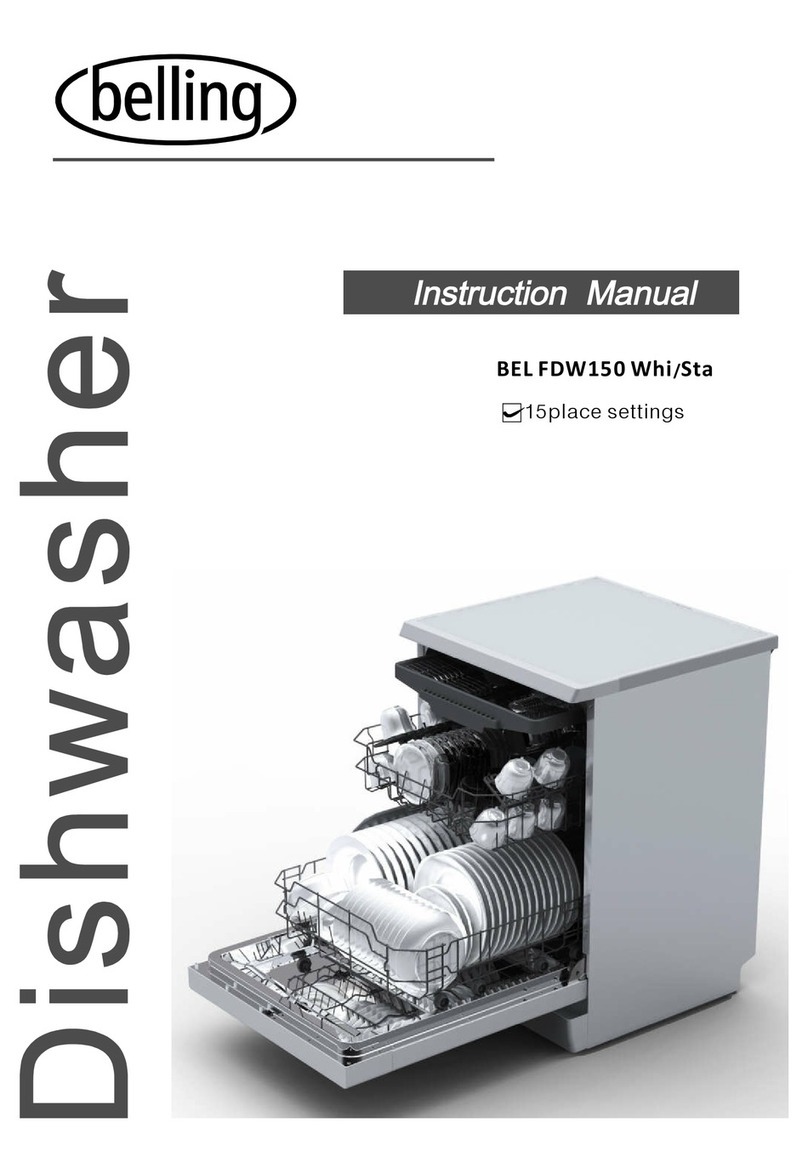
Belling
Belling BEL FDW150 Whi Sta User manual

Belling
Belling BDW60WTE User manual
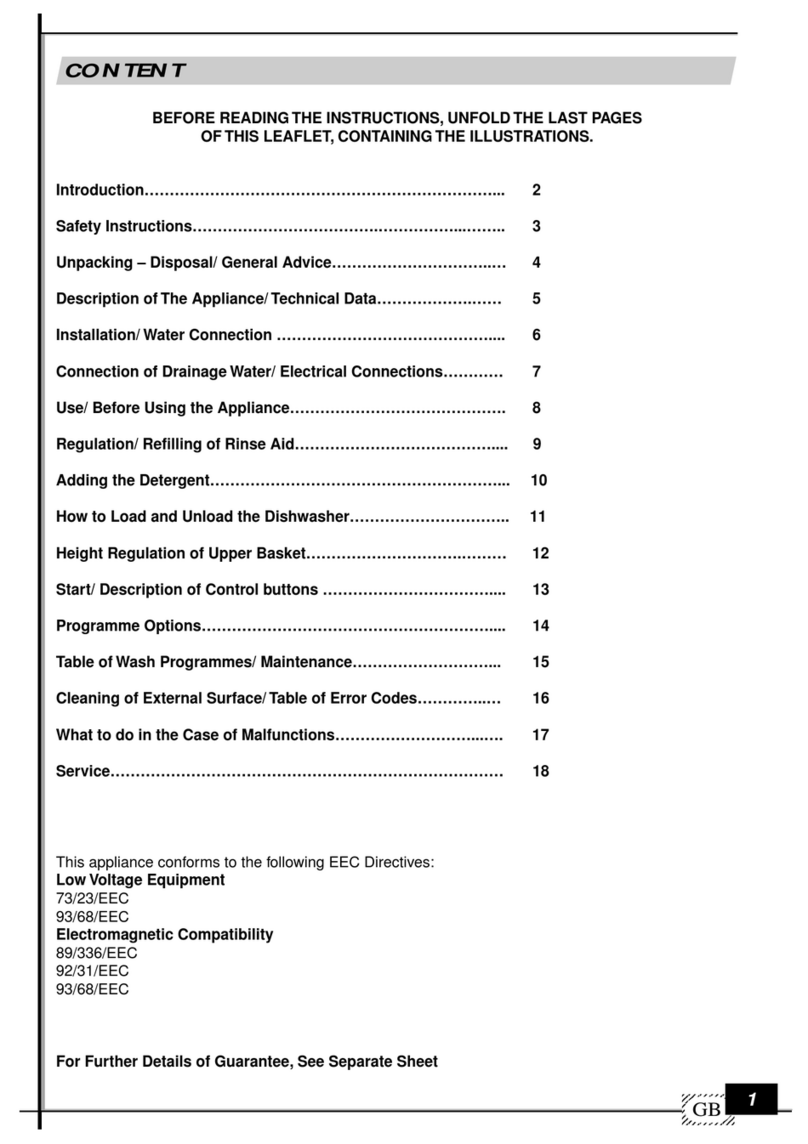
Belling
Belling IDW603 Instruction manual

Belling
Belling BDW60IC User manual

Belling
Belling IDW604MK2 User manual

Belling
Belling BEL IDW45 User manual
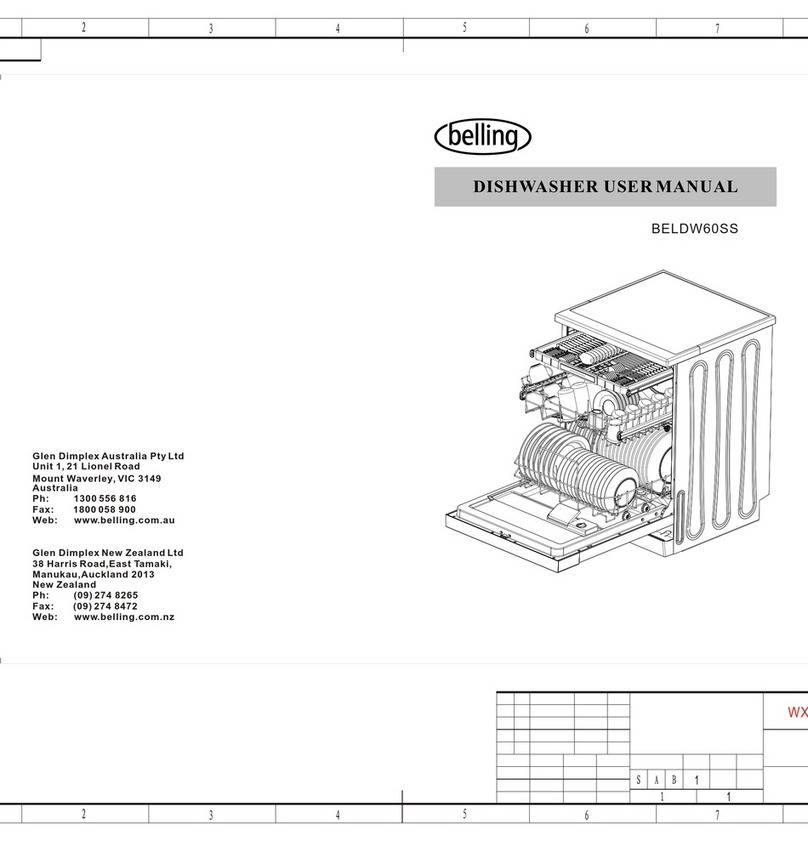
Belling
Belling BELDW60SS User manual
